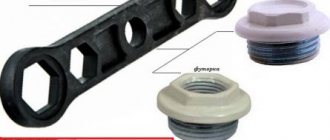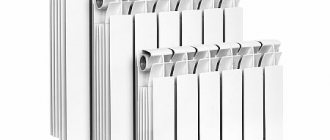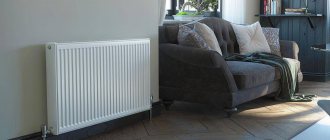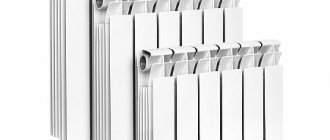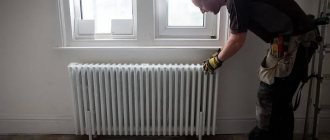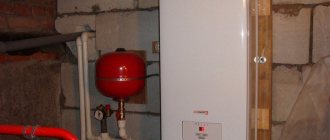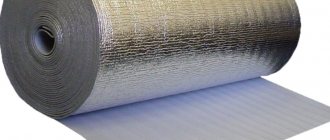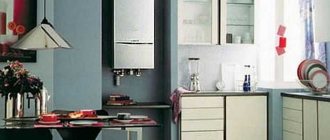Bimetallic radiators are a new trend in residential heating. Such heaters can increasingly be found in apartments and private houses. And in this article we will help you figure out which bimetallic heating radiators are better and how they are superior to aluminum and semi-bimetallic devices. You can also find important tips on choosing a heating radiator and interesting videos on this topic.
Bimetallic radiators are quickly gaining momentum Source kvartirnyj-remont.com
Bimetallic or semi-bimetallic radiators
Bimetallic heating devices are steel pipes connected by cold welding, which are coated with a layer of aluminum. Thanks to this, hot water does not interact with the outer shell of the radiator, which avoids corrosion. Moreover, aluminum is applied in the form of shaped plates, and this significantly increases the heat transfer area.
There are also copper cores for bimetallic radiators. They are suitable if the coolant is water with antifreeze. This composition can quickly destroy steel, but copper is resistant to it.
Semi-bimetallic radiators have a core made of two metals. All vertical channels are steel, and horizontal ones are aluminum. The disadvantage of such devices is that they are not suitable for water with a high alkali content. They definitely require a coolant purified from impurities.
Now there are many different brands on the market offering high-quality antifreeze. One of them is Gibax brand antifreeze. When choosing, you must remember that ethylene glycol and propylene glycol bases are not used in systems with galvanized pipes. For them, coolants made on the basis of glycerin are used.
Now about which heating radiators are better. For central heating systems, bimetallic devices are more suitable because they are resistant to pressure drops and low-quality contaminated coolant.
For an apartment it is better to choose bimetallic heating devices Source homeli.ru
Semi-bimetallic radiators are more efficient, but they require ideal conditions to function properly. They are more suitable for private homes, and are an order of magnitude more expensive than bimetallic devices.
Types of Flat Panels
The thinnest radiators on the market are represented by two types of panels: type 10 and type 11. At its core, a type is a numerical abbreviation in which the design of the device is encoded. The first digit of the type indicates the number of radiator panels, and the second digit indicates the absence (if “0” is used) or the presence of convection fins and the number of their rows.
Type 10: one of the thinnest single-panel radiators without convection.
Type 11: single panel flat radiator with 1 row of convection sheets.
A comparison of the features of thin heating radiators of types 10 and 11 is presented in the table.
| Device type | Photo | Peculiarities | Width, mm |
| Type 10 | Flat single-panel radiators without convection do not raise dust and are easy to maintain, therefore they are most often used in rooms with increased sanitary and hygienic requirements: in medical institutions, preschool and educational institutions, food and pharmaceutical manufacturing enterprises. | 46-50 | |
| Type 11 | Flat single-panel radiators with one convection row, due to which the heaters have a heat output 5-10% higher than their single-panel counterpart without convection. The presence of convection leads to the movement of air and, accordingly, dust, so this type of device requires more frequent and thorough surface care, otherwise their advantage over type 10 heaters will be lost. | 61-64 |
Some bimetallic models can also be classified as thin, for example, Oasis BM 500/80 with a thickness of 80 mm. Bimetallic heating devices are a more expensive alternative, but have greater heat transfer and a higher permissible operating pressure limit. They can be used if, according to preliminary calculations of heat transfer, even the widest steel radiators are simply not enough to heat the room.
Heat transfer from heating radiators Comparison of indicators and calculation methods
Bimetallic or aluminum radiators
A little about which radiators are better, aluminum or bimetallic. In relation to the coolant, the advantage is clearly on the side of the latter. Aluminum does not withstand prolonged contact with water with large amounts of impurities.
Also, bimetallic radiators are more resistant to high pressure than aluminum ones. After all, the core is made of alloy steel, which has increased fracture and tensile strength.
However, in some aspects, bimetallic heaters are inferior to aluminum ones. They are bulkier and heavier, cost significantly more, and the steel core reduces energy efficiency and reduces heat exchange with the room.
Externally, aluminum and bimetallic radiators are very similar Source zamenabatareymoskva.ru
Bimetallic heaters definitely require increased heating costs. But they are more durable and more suitable for urban heating networks. At the same time, aluminum radiators are ideal for private homes, where owners can control the pressure and change the water in the system.
See also: Catalog of companies that specialize in equipment for engineering systems, including heating
Advantages and disadvantages
When determining which radiator is best to choose, you need to weigh all the advantages and disadvantages of using bimetallic structures.
The advantages include the following features:
- easily adaptable to the interior of residential and office premises;
- have a variety of colors and can be painted in the desired color;
- safety of the structure due to the smoothness of the surface;
- suitable for all types of heating systems, have a long service life;
- withstand increased pressure in the system and extreme temperatures of the coolant;
- excellent heat dissipation and the ability to adjust temperature;
- possibility of selecting the size of the radiator according to the number of sections.
But along with such advantages, there are bottlenecks.
Firstly, low-quality coolant can negatively affect the design.
Secondly, differences in the expansion levels of the two metals can cause noise in the circuit with a consequent reduction in reliability and efficiency.
Thirdly, clogging is possible, which additional filters at the inlet will help prevent. Fourthly, the best bimetallic radiators are quite expensive.
Types of bimetallic radiators
There are two main types - sectional and monolithic. Below we will tell you more about them and help you figure out which one is best for you.
Sectional radiators
They are assembled from several sections. Often made in the form of a “layer cake” made from heating plates. This discovery allows one to significantly increase the area of heat exchange with the environment. But there is a big drawback: any coolant destroys the joints of its component parts. As a result, a relatively short service life.
Sectional heaters consist of several parts Source forum.usolie.info
Monolithic radiators
They also have a large heat exchange area, so they are in no way inferior to sectional heaters. One section produces approximately 100-200 W. Monolithic radiators are manufactured using a fundamentally new technology: the entire body is cast and then pressure-treated. A layer of aluminum is applied under pressure on top of the steel frame.
Monolithic heaters are one whole Source www.teplodvor.by
The advantage of monolithic radiators is obvious. The service life is twice as long and is not 25 years, like sectional ones, but 50. But at the same time, they cost about a fifth more. Their disadvantage is that they do not allow adding additional sections and thereby adjusting the power.
If you think about the question of which heating battery is better for apartments in high-rise buildings, then the answer is clear - monolithic. The point is a large pressure drop due to altitude.
Rating of bimetallic heaters
Below we will help you figure out which batteries are best to choose for your home or apartment. Let's consider the operating conditions, workmanship and some nuances.
Global Style Plus 500
Suitable for central heating systems. Well adapted to high pressure and strong acidity of the coolant. The sections are connected by pipes with a silicone gasket that protects against leaks. The steel contour is crimped under high pressure, which allows it to withstand strong water pressure. Another advantage of this model is the high quality of painting.
Bimetallic heater Global Style Plus 500 Source m.onlinetrade.ru
But the downside will be the rather high cost. On average on the market it is 9,500 rubles. However, it is believed that the model is worth the money.
See also: Catalog of companies that specialize in the development of circuit diagrams and installation of engineering communications of any complexity
Rifar Monolit 500
A monolithic heater made in Russia, quickly gaining popularity. Made in the form of a single steel block, which eliminates the possibility of leaks. The radiator does not require a constant coolant temperature. Withstands pressure on the internal circuit up to 100 atmospheres. Rifar Monolit 500 provides high heat output with minimal energy loss.
Rifar Monolit 500 - a good heater from a domestic manufacturer Source klimatstandart.com
But there is one caveat: the dimensions of the Rifar Monolit 500 heating radiator are fixed, like any monolithic device. Therefore, if it turns out that there is not enough of it or, on the contrary, there is too much, simply adding or subtracting sections will not work.
Prices: summary table
A comparative analysis of the characteristics of flat steel radiators with a height of 500 mm and a length of 1000 mm is presented in the form of a table.
| Model | Working pressure, bar | Heat dissipation, W t | Coolant volume, l | price, rub. |
| Kermi FKO 10 500x1000 | 10 | 839 | 2,6 | From 2889 |
| Buderus Logatrend K-Profil 11 500x1000 | 10 | 1018 | 3,2 | From 2307 |
| Royal Thermo HYGIENE 10 500x1000 | 8,7 | 868 | 2,7 | From 2893 |
| Axis Classic 11 500x1000 | 9 | 1227 | 2,8 | From 2588 |
| Prado Classic 10 500x1000 | 9 | 1211 | 2,84 | From 2338 |
Video description
We recommend watching this short video review of the bimetallic radiator Rifar Monolit 500:
Sira RS Bimetal
One of the quietest heating radiators. Can even be installed in bedrooms. One block can include up to 12 sections, the number of which can be adjusted depending on the area of the room. The inner shell is made of special steel, which is not subject to corrosion and can be used in combination with low-quality coolant. Sira RS Bimetal provides a high level of heat transfer and is designed for a maximum pressure of 40 atmospheres, and the radiator is adapted to the water hammer typical of a central heating system.
Heating radiator Sira RS Bimetal can often be found in apartments Source on-lineclimat.ru
But this model has one drawback: the quality of painting leaves much to be desired. Despite this and the rather high cost, many experts, when asked which bimetallic radiators are better, will answer Sira RS Bimetal.
Royal Thermo Revolution Bimetall 500
Fourth place in our ranking of bimetallic radiators is occupied by Royal Thermo Revolution Bimetall 500. A very popular model from a domestic manufacturer. The device is adapted to fairly harsh operating conditions and provides good performance. The structure is wall-mounted, sectional, with an adjustable number of segments, the maximum number of which is 14 pieces. The Royal Thermo Revolution Bimetall 500 has a side connection. The heater is designed for operating pressure up to 30 atmospheres.
Bimetallic heating radiator Royal Thermo Revolution Bimetall 500 Source smauro.ru
The main factor that makes the model one of the most widespread in Russia is the price. You can buy a heater for an average of 4,100 rubles. However, it is worth remembering that with sharp increases in coolant temperature, the efficiency of the device decreases significantly.
Reviews of thin panel heating devices
| Advantages | Flaws |
| Saves space due to its small width | At risk of destruction at welded seams due to possible water hammer |
| Small volume of coolant and, as a consequence, high inertia and functionality of the system | Deformation of the panels during operation or installation can lead to obstruction of the coolant channels, thereby damaging the radiator |
| Due to radiation through radiation, type 10 panels do not dry out the air and do not transfer dust masses | Reduced efficiency and relatively low thermal output |
| Installation of devices is extremely simple and straightforward (however, it is better to contact specialists). | High probability of corrosion due to improper use |
| Wide selection of panels according to geometric parameters and heat transfer | It is strictly not recommended to drain the coolant, as this can accelerate the process of corrosion formation |
| Possibility to select heaters for any construction project, based on the required connection method | |
| Less dangerous due to their shape |
How to choose a bimetallic heater
When purchasing a device, it is important to consider a number of nuances. When going to the store, you need to know exactly what power the radiator should produce, what dimensions it should have, and to what conditions it should be adapted. Therefore, we will help you figure out which bimetallic radiator is best for your home.
Calculation of the number of sections
This calculation is made based on the area of the room and the energy efficiency of the section of a particular device. It is believed that for every 10 m2 of room there should ideally be 1 kW of power. To calculate, you need to divide the area of the entire room by 10, and then divide the result by the power of one section. Then the entire value must be increased by 10% and rounded to the nearest whole number. This is how heat loss associated with external factors is taken into account. The result will be the optimal number of radiator segments for a specific room.
A sectional bimetallic radiator can be adapted to a specific room Source cok.ru
If, due to some characteristics of the area or the house, the sectional heater does not provide the required temperature level, additional segments can be added to it. This cannot be done with a monolithic radiator.
Things to consider
There are several points that are worth paying attention to in order to understand which heating radiator is better in a particular case:
- It is better when the size of the heater is maximum , because in this case the energy efficiency of the device is the highest. But it is important that the distance to the floor is at least 12 cm, and to the window sill - at least 10 cm.
Ideally located bimetallic heating radiator Source tengrinews.kz
- Capacity is one of the most important parameters. The larger it is, the better the radiator heats. Therefore, devices with small volume sections require the highest quality coolant without impurities.
- Monolithic radiators are more suitable for apartments , because they can withstand sudden pressure surges, while at the same time, cheaper sectional models can be used for autonomous heating systems.

